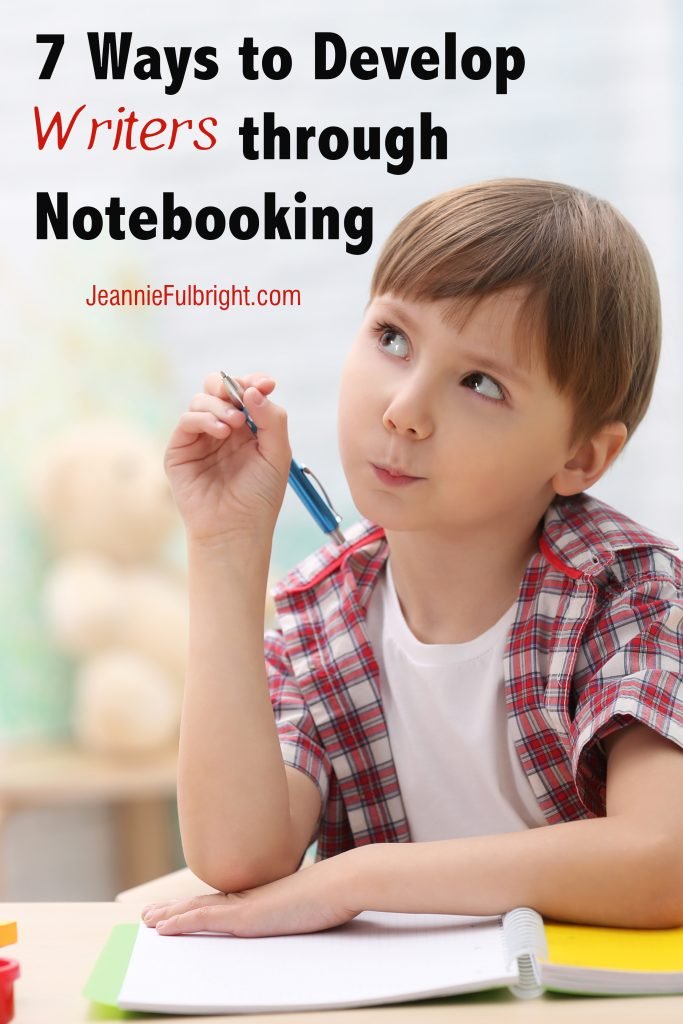7 Ways to Develop Writers Through Notebooking
Notebooks are living books—creative expressions of a child’s learning. When our children engage in notebooking, they are uniquely authoring their own book filled with authentic ideas and expressions they will treasure forever.
Some people mistakenly believe notebooking is all about writing, but that’s not true at all. While notebooking can and often does include writing, it’s really about building—building a book of learning. And there are no blueprints for how to build.

Each child will approach notebooking differently. Some children will write a lot, while others will write only a little. Either way, as your child engages with creativity to build his notebook, he will be creating his own living book.
Many children struggle to write, and we have to be careful not to push them to write too early, requiring something of them they aren’t ready for. We can’t assume every child should be where other children are in their writing skills. We need to let that go.
As homeschool moms we have the freedom to allow our children to progress at the speed in which God has created them to learn.
When they are not mentally and academically ready, our children will end up thinking they aren’t good at writing and will learn to loathe it. Writing will forever be a drudgery for them. And for us.
My boys hated to write throughout much of our homeschooling journey. It was like pulling teeth to make them write. They resisted writing. They were allergic to writing!
Because I was convinced notebooking was a superior method of education and was committed to it in our homeschool, I had to find ways for my “nonwriters” to become successful at it. And that’s when I discovered that notebooking isn’t really about the words our children write; it’s about their use of creativity.
When your children are just beginning to notebook, have them start with writing a title. This worked perfectly for my daughter’s first notebooking assignment at age five. I had her listen to a story about King Midas then write a short title: King Midas. By simply writing that title, she remembered everything about the story. It was the perfect writing assignment for her at that age.
After gaining experience with writing titles, we graduated to writing one sentence. Then a few sentences. Then we added more sentences, and finally paragraphs. You can come up with a required number of sentences per year per child.
For instance, in third grade, require your children who are ready to write seven sentences for each assignment. This is plenty. A lot can be said in seven sentences especially if they are well written sentences. My older daughter could have written two pages in third grade; however, three sentences was about all my boys could handle at that age.
Require of each child what is right for them at that time based on what they are capable of learning, then slowly progress them to more writing as they mature. Of course, we want to challenge our children and move them closer to the end goal of strong composition skills but not to the point of frustrating them.
Ask God for wisdom as you consider each child’s capacity for writing at each stage during your homeschool.
Do you have a child who absolutely refuses to write? Don’t despair! Not all is lost in notebooking! There are lots of alternatives to writing, and your child will grow in his learning no matter how he spends his time creating his notebook.
Here are some alternatives to writing that worked well for our children as they built their notebooks:
Draw Lots of Pictures
My children remembered what they learned through the process of illustrating their learning. They had to think about and mull over what they learned as they created a visual expression of their newfound knowledge. This is the brilliant thing about notebooking.
Before children can record their learning they have to think about their learning and how to communicate it in pictures and words. Their brains are going over the subject matter, and they are spending more time with the knowledge as they do the creative work. The learning is solidified in their mind and they gain ownership of the information.
It becomes their own knowledge. Living knowledge.
Many times we would create a page after a field trip and the children would add pictures with simple titles and personal drawings. Not many words were penned but they remembered the material. Finding the right pictures on the internet and taking time to think about and present the information was perfect for notebooking a field trip. And it didn’t require much writing at all.
Create Lapbooks
Lapbooks are small books of personalized learning that do not require a lot of writing. After creating a lapbook, the child glues it into his notebook. There are many different types of lapbooks that can spur your child’s creativity.
The notebooking journals I created as companion products to my science books all have lapbooks. They add a lot of interest and fun to the child’s notebook and are one of the highlights for children who do my notebooking journals!
Create PowerPoints
These are perfect for the tech lovers in your homeschool! It’s as easy as typing a few sentences or phrases and using creativity to choose colors and design elements to make the informational slides look amazing! My boys loved to create PowerPoints. I would print them out and they would put them in their notebook.
Utilize Dictation
Dictation worked well for my boys. They would first draw a picture of what they learned then express to me their knowledge of the subject based on their drawing. I would type what they told me exactly like they said it. Then I would print it out. My boys would cut out the words and glue them on the page next to their drawing.
Some moms write out what their children dictate, then have them copy their dictation into their notebook. Both of these methods work beautifully for the resistant writer!
Keep Collections
This is a fun way to enhance both the notebooking experience and the end result. There are many “sciencey” type things your children can collect, especially if they are studying botany. My children had so much fun outdoors collecting leaves and all things nature to glue in their Botany Notebooking Journals. Spending time outdoors was an added bonus as they built their notebooks.
Purchase Postcards from Travels
I love this idea if your children are building a notebook for a different country or special place in the country where you live. Postcards come in many styles and a simple notebook can be built around them with a simple word or phrase added beneath each for a personal touch.
Do Hands on Projects and Photograph Them
We homeschoolers love hands on learning! But what do we do with all those beautiful 3-d creations? How do we preserve them? With a photograph! I remember taking a picture of a Viking ship my daughter built from clay when we were notebooking about history. I printed it and she placed it in her notebook.
The sky’s the limit when it comes to notebooking! Remember, it’s not about writing a book of knowledge; it’s about building one—and constructing with whatever materials help our children uniquely express their knowledge about all they learned.
Though notebooking is an academic pursuit, it should be an enjoyable activity that makes learning exciting and compels our children to love it.

